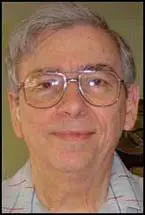Ron Ecker

Ron Ecker was born in Jacksonville, Florida, on 8th February, 1942. He received his BA in English at the University of Florida in 1964, and spent two years as a Peace Corps Volunteer in Peru. He earned a Masters in Library Science degree at Florida State University, and spent almost 20 years as a librarian with the state of Florida.
Ecker became interested in the assassination of John F. Kennedy after reading Best Evidence (David Lifton). He created a website on the assassination called Ecker's JFK Web Pages. It includes articles he has written on the JFK assassination, as well as links to other JFK materials.
The author of several books, Ecker took early retirement in 2000 to become a full-time writer. His books include the Dictionary of Science and Creationism, And Adam Knew Eve: A Dictionary of Sex in the Bible, The Evolutionary Tales: Rhyme and Reason on Creation/Evolution, and the vampire novel (writing as William Pridgen) Night of the Dragon’s Blood. His modern-English translation of The Canterbury Tales has been a widely adopted text in college and university literature courses.
Primary Sources
(1) Ron Ecker, The Umbrella Man (June, 2004)
Imagine this. U.S. President John F. Kennedy rides in an open limousine into Dallas's Dealey Plaza. The limo is followed in the motorcade by a car full of Secret Service agents. Nothing looks suspicious, unless you count the absence of police motorcycles both in front of and beside the limo (the Secret Service ordered that the motorcycles stay to the rear of JFK's car, which led the House Select Committee on Assassinations to call the Dallas motorcade "uniquely insecure"). 1 There was also the choice of motorcade route, with that slow, tight turn onto Elm Street, seconds before rifle shots ring out. Such slow speed and tight turns can clearly be dangerous for a president riding in an open car. (One familiar with presidential motorcades might also wonder about the absence in Dallas of the usual press truck, with all of its cameras, in front of the President's limo.) And when shots are heard, and Secret Service agent John Ready jumps off the running board of the follow-up car, intent to run to JFK's limo (which driver William Greer slows down, of all things), SS agent in charge Emory Roberts in the follow-up car calls Ready back. Agent Clint Hill runs to the limo anyway, climbing onto the back of it, as the limo finally speeds up after JFK has been fatally shot in the head.
But never mind the unique insecurity, the route, and the behavior of the Secret Service. Nothing else looks suspicious, till after that slow turn onto Elm Street. Imagine this. There's a man, on this bright sunny day, standing on the sidewalk right where the President is about to pass, who opens an umbrella. Not only that, but (as seen in the Zapruder film) he rotates the open umbrella while he's standing under it, as if somehow tracking the President with it as the limo approaches. Now the man pumps the umbrella up and down, as if signaling, right after JFK is first shot. Not only that, but there's a slim, dark-complected man standing on the sidewalk near the umbrella man who, after JFK has been hit, raises one hand high in the air. And after more shots have been fired, fatally wounding the President, and while everyone else is running about or fearfully lying low on the plaza grass, the man with the umbrella calmly lowers and closes it. Then he and the dark-complected man, with chaos all around them, casually sit down together on the curb. The dark-complected man apparently says something into a radio, then conceals it in his back when he and the umbrella man, having taken their respite on the curb, stroll away in opposite directions.
(2) Ron Ecker, The Tokyo Flight (October, 2004)
When President John F. Kennedy was assassinated in Dallas, Texas, on November 22, 1963, six members of his Cabinet plus his press secretary were out of the country, together on an airplane en route to Tokyo, Japan. Some JFK conspiracy theorists have seen this group absence of key government officials from Washington during the assassination as more than a coincidence.
"We believe it was by design," J. Gary Shaw writes in his book Cover-Up, "that Secretary of State (Dean) Rusk, Treasury Secretary Douglas Dillon, Interior Secretary Stewart Udall and Labor Secretary W.W. Wirtz, as well as other administration officials like Press Secretary (Pierre) Salinger, were trapped in an airplane over the Pacific Ocean at such a critical time." 1 (The other two Cabinet members aboard were Secretary of Commerce Luther Hodges and Secretary of Agriculture Orville Freeman. Cabinet members not on the trip were Defense Secretary Robert McNamara, Attorney General Robert Kennedy, HEW Secretary Anthony Celebrezze, and Postmaster General John Gronouski.)
Shaw also writes of a problem the Rusk party had in communicating by radio with the White House because "the official code book was missing from its special place aboard the plane" (italics in original), a suspicious circumstance reiterated by Robert Groden and Harrison Livingstone in their best-selling book High Treason.
The late Colonel L. Fletcher Prouty, who in 1963 was Chief of Special Operations for the Joint Chiefs of Staff (and who was the basis for the military character "X" in the Oliver Stone film JFK), was also out of the country that day, having been sent on a mission to the South Pole. In his 1992 book JFK, Prouty wonders, "Were there things that I knew, or would have discovered, that made it wise to have me far from Washington, along with others, such as the Kennedy cabinet . . . ?"
Similarly, researcher Vince Palamara is suspicious about the presence of Salinger on the Tokyo flight instead of in Dallas, where the press secretary's knowledge of motorcade planning and security might conceivably have made a difference.

